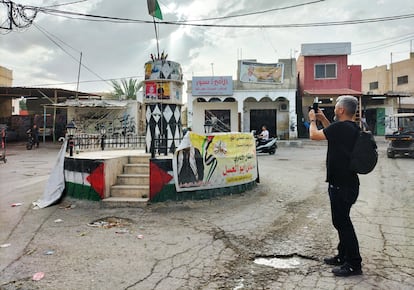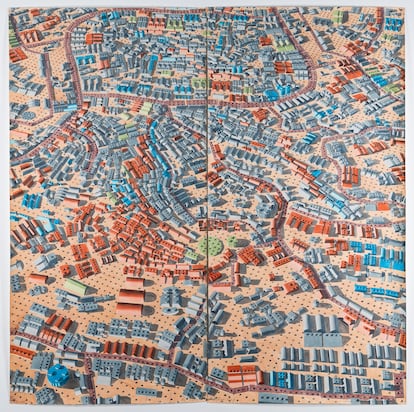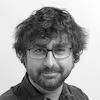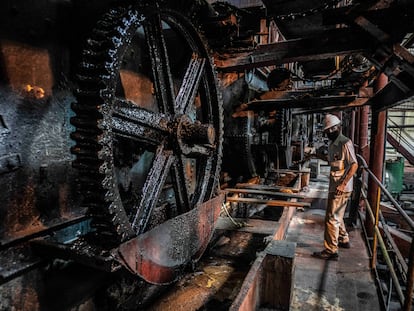Dagoberto Rodríguez, painter of refugee camps
The Cuban artist visited Palestine after almost three years of recreating, from a distance, places like Zaatari or Dadaab in watercolor

In 2020, in the midst of the Covid-19 confinement, the Cuban creator Dagoberto Rodríguez, co-founder of the prestigious — but inactive since 2018 — conceptual art collective Los Carpinteros (The Carpenters), began to recreate refugee camps in watercolor. His process consists of finding them on Google Earth, selecting a fraction (“I try to understand where the action takes place,” he explains) and creating three-dimensional Lego models of them on his computer. The resulting image serves to project, draw and paint a watercolor — one of his favorite techniques — which offers a bird’s-eye view that is half playful and half puzzling. He has done this, for example, with camps such as those of the Rohingya in Bangladesh; Zaatari in Jordan, caused by the Syrian war; and Dadaab, where approximately 350,000 Somalis who fled the civil war, and later drought and famine, eke out survival in Kenya.
Born in 1969 in the city of Caibarién, Rodríguez graduated from the Higher Institute of Art in Havana in 1994. There he met the other two original members of Los Carpinteros, the collective with which he reached his zenith of recognition and with which he opened a studio on the island in 2015, in the midst of an economic opening promoted by Raúl Castro that allowed them to buy the space. With Los Carpinteros or by himself, he has exhibited at MoMA and the Guggenheim in New York, the Tate Modern in London, the Georges Pompidou Center in Paris and the Reina Sofía in Madrid, among others. In 2021 he obtained the EFG Latin American art award.

The idea to turn refugee camps into art stemmed from his life experience. First, from his own journey as a resident in Madrid, Spain, since 2009. “Everything that has to do with migration connects a lot with our own experience. Our journey into exile is that of any refugee,” he points out. “At the end of the story, you say: ‘You belong to art, and so on... but you’re a refugee.’”
Second, from a much harsher feeling: Cuba “has ceased to be a political project to become one of survival” and its capital is now “a large refugee camp,” he states. “Havana is becoming a favela. It used to have a defined structure but it has been undergoing a backwards process […] It lives on international aid. And the people are there temporarily. The final destination in Havana is not Havana, but Miami or Spain,” he says. The artist, in fact, has a provocative watercolor in which he recreates the city’s port with the same technique and visual language. Its title is Havana Refugee Camp.

After two and a half years of using Google Earth, Rodríguez felt the need to go one step further. To add the street-level view to the one provided from above by technology. “I’m interested in symbolic production, seeing how people organize the space,” he explains. For this he chose Palestine, a place that has been present in his life since his childhood, in speeches in support of the revolution in Cuba, which broke off relations with Israel after the Yom Kippur War (1973) and declared official mourning for the 2004 death of the historic Palestinian leader Yasser Arafat.
“This is practically a city,” he says as he walks with family and friends through the streets of Aqabat Jaber, the camp in the West Bank city of Jericho that is home to 10,000 refugees, as well as another 3,000 Palestinians who are not refugees but moved there because of the housing prices.
Aqabat Jaber has little to do with the refugee camps that many might imagine with tents, muddy children and tanker trucks. Here, 75 years after the Nakba (the expulsion or flight of two-thirds of the Palestinians who lived in present-day Israel), the houses are made of concrete. At first glance, the only thing that distinguishes it from a normal neighborhood in a Palestinian city are the banners paying tribute to those killed in the conflict with Israel, the piles of garbage (the employees of the UN agency that manages the camps are on strike) and the blue color of the United Nations in schools and medical centers. After a while, Rodríguez notices something else: “It wouldn’t be very different from any suburban neighborhood if it weren’t for the faces, the expressions... there’s a lot of tension.” Jericho is one of the quieter cities in the West Bank, but in recent weeks it has been the target of several Israeli military raids, including one just 72 hours before the artist’s visit.
Rodríguez stops from time to time to take photos with his cell phone. He is captivated by a fountain decorated with Palestinian flags and posters of the latest martyrs of the Israeli incursions. It looks, he says, like a “political art installation.” He is also struck by the horizontality of the buildings, which differ from another camp he visited: Aida, in Bethlehem, where the lack of space pushes the housing towards verticality.
What interests him most is the spatial organization, and its translation into a creative language. Thus, while others pose political questions to a local representative, what he wants to know is if there is something akin to a movie theater in the camp (they set up an outdoor screen in the summers) or who grants building permits. Afterwards, he circles back to his own experience: “The Cuban government does to us what Israel does to the Palestinians.”
Sign up for our weekly newsletter to get more English-language news coverage from EL PAÍS USA Edition
Tu suscripción se está usando en otro dispositivo
¿Quieres añadir otro usuario a tu suscripción?
Si continúas leyendo en este dispositivo, no se podrá leer en el otro.
FlechaTu suscripción se está usando en otro dispositivo y solo puedes acceder a EL PAÍS desde un dispositivo a la vez.
Si quieres compartir tu cuenta, cambia tu suscripción a la modalidad Premium, así podrás añadir otro usuario. Cada uno accederá con su propia cuenta de email, lo que os permitirá personalizar vuestra experiencia en EL PAÍS.
¿Tienes una suscripción de empresa? Accede aquí para contratar más cuentas.
En el caso de no saber quién está usando tu cuenta, te recomendamos cambiar tu contraseña aquí.
Si decides continuar compartiendo tu cuenta, este mensaje se mostrará en tu dispositivo y en el de la otra persona que está usando tu cuenta de forma indefinida, afectando a tu experiencia de lectura. Puedes consultar aquí los términos y condiciones de la suscripción digital.
More information
Archived In
Últimas noticias
Maduro pleads not guilty before the federal court in New York: ‘I am still the president of Venezuela’
A new test can detect Alzheimer’s from a finger prick
UN team enters Sudanese city of El Fasher after paramilitary massacre: ‘It’s like a ghost town’
A recipe for resistance: Indigenous peoples politicize their struggles from the kitchen
Most viewed
- Gilles Lipovetsky: ‘If you want to live better and fall in love, take Prozac, don’t look to philosophy’
- Alain Aspect, Nobel laureate in physics: ‘Einstein was so smart that he would have had to recognize quantum entanglement’
- Alvin Hellerstein, a 92-year-old judge appointed by Bill Clinton, to preside over Maduro’s trial in New York
- Maduro’s downfall puts China’s relationship with Venezuela to the test
- Why oil has been at the center of Venezuela-US conflicts for decades











































